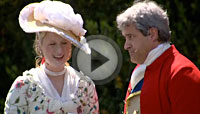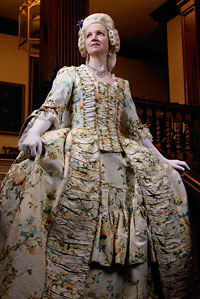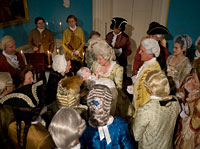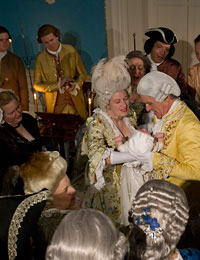Page content
Lady Dunmore, Charlotte Murray
- Married first cousin Lord Dunmore in 1759
- Followed Lord Dunmore to America in 1773
- Much beloved figure known for ladylike grace and charm
- Mother of nine children
High rank by birth and marriage
Lady Charlotte Stewart was the sixth daughter of Alexander Stewart, 6th Earl of Galloway, and the former Lady Catherine Cochrane. Lady Charlotte Stewart became Lady Charlotte Murray, Countess of Dunmore, when she married John Murray, 4th Earl of Dunmore on 21 February 1759. The bride and groom were first cousins, once removed. Her grandmother Lady Anne Murray was the daughter of Charles Murray, the 1st Earl of Dunmore, the 4th Earl’s grandfather.
A reputation for charm
Lady Dunmore soon became known for her charm. In May 1761, Lord Dunmore became one of the 16 Scottish peers to sit in the British Parliament. As such, he and Lady Dunmore, although she was pregnant with their second child, participated in the Coronation Procession of the young King George III in September. Horace Walpole, seeing her on that occasion, wrote that “there were two new Scotch peeresses that pleased every body, Lady Sutherland and Lady Dunmore.” Later that year Lady Sarah Lennox pronounced Lady Dunmore “charming.” The Countess of Dunmore moved in the highest London circles, even visiting with the queen.
In January 1770, Lord Dunmore was appointed Governor of New York, and he departed for America in the fall. At his departure, Lady Dunmore stayed in Britain. She was pregnant with their eighth child, a boy who was born in December and christened Leveson Granville Keith Murray, in honor of Lord Gower. Dunmore was less obliged to Lord Gower when the Lord President arranged for Dunmore’s transfer to Virginia, a change Dunmore had not sought and did not wish to make.
Voyage to America
Lord Dunmore, finding that he could not return to England to visit his family without relinquishing his governorship, sent for Lady Dunmore in the spring of 1773. At nearly the same time, their son William died. In mid-June 1773, Lady Dunmore apparently had not yet received the summons from her husband, as she planned to go abroad in the autumn and visit Naples. She immediately changed her plans, however, on learning of her husband’s wishes, intrepidly making a winter crossing of the Atlantic with three sons and three daughters. She left the baby in England with her sister.
The family reached New York January 2, 1774, after 44 days at sea, and Lady Dunmore immediately made a favorable impression. Gouvernour Morris, an experienced connoisseur of womankind, described her as “a very elegant woman,” who “looks, speaks, and moves and is a lady.” She and the children stayed in New York for about a month, and then made their way to Virginia by sea, stopping at Philadelphia, Baltimore, and Annapolis.
Arrival amid fanfare
They arrived at Yorktown February 26, where they received a cannon salute, which unfortunately caused great injury to several men manning the cannon. The party traveled on to Williamsburg, where the city was illuminated and a crowd of citizens escorted them to the Palace. Over the next several days there were fireworks and congratulatory addresses at their safe arrival. The House of Burgesses officially welcomed her at a ball on the 27th of May, the day after their assembly had been dissolved by Lord Dunmore for passing resolutions for a day of fasting, humiliation and prayer in support of the Bostonians, whose port was to be closed on June 1st in consequence of the Boston Tea Party.
Lord Dunmore led a military expedition to the west against the Shawnee in the summer of 1774, leaving Lady Dunmore and the children in Williamsburg. She gave birth to a daughter on December 3rd, the day before his return. On the Queen’s birthday, January 18th, the baby was christened Virginia, in honor of the colony, and the Queen’s birth night and Lady Virginia’s christening were celebrated at a ball at the Palace the same evening.
Beloved by Virginians
Lady Dunmore appears to have thoroughly won the good opinion of the Virginians. Even when difficulties with her husband arose in the prelude to the Revolution, the colonists were quick to assure Lady Dunmore of their affection for her. The Dunmore family left the Palace twice in the spring and early summer of 1775 in consequence of the unrest, and Lady Dunmore and the children left for England on June 9th.
While Lord Dunmore remained in Virginia, Lady Dunmore and their eldest daughter were apparently in Paris in 1776. After a series of military engagements in Virginia, Lord Dunmore sailed for New York in August 1776 and arrived in England in 1777. He once again sat in the House of Lords. When he returned to America from 1781 to 1782, his wife did not accompany him. Lord Dunmore was appointed governor of the Bahamas in 1787, but appears that he departed for his post without Lady Dunmore.
Scandal in Italy
In the early 1790s she was in Italy with her daughter Augusta, when the young Prince Augustus Frederick, son of George III, met and courted Augusta. They were married in Rome in the spring of 1793 in defiance of the Royal Marriage Act, but the marriage, which produced two children, was ordered annulled by King George III. Likely as a result of royal disfavor, Lord Dunmore was recalled from the Bahamas in 1796.
Lady Dunmore was living at Ramsgate, Kent, by 1804. Perhaps the scandal of her daughter’s annulled marriage followed her there for it was said that she was “visited by very few proper people.” Lord Dunmore died there on February 25, 1809, and Lady Dunmore became a widow. She never remarried. Lady Dunmore died November 11, 1818.




